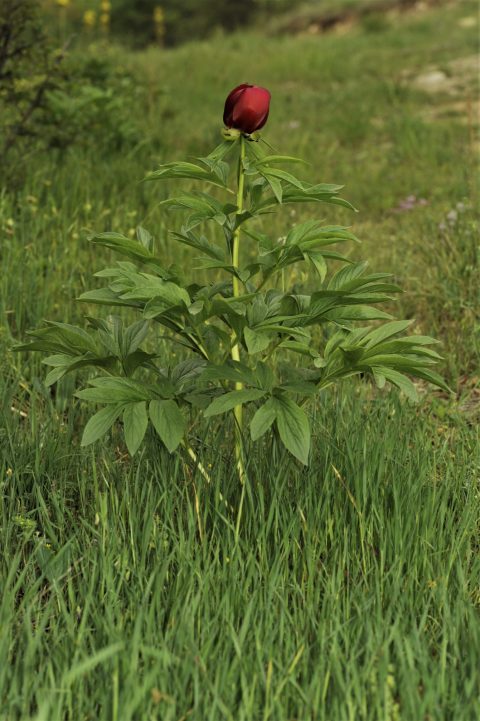[print_posts pdf=”yes” word=”yes” print=”no”]Paeonia saueri(1)
Perennials. Lateral roots tuberous, tubers fusiform. Stems 45—65 cm tall, green, rarely purple, glabrous. Lower leaves biternate, with some leaflets segmented, leaflets/leaf segments 19—45 in number, all entire or very few lobed, elliptic or narrow—elliptic, cuneate at the base, acute at the apex, 3.3—11 cm long, 1.0—4.2 cm wide, with bristles along veins above, sparsely hispidulous, very occasionally glabrous beneath. Flowers solitary and terminal; involucrate bracts 2-3 in number, leaf—like; sepals 3—5, rarely 6 in number, glabrous, all rounded but sometimes one caudate at the apex, 2.5-3.0 cm long, 2.0—2.5 cm wide; petals 7—10 in number, red, obovate, cuneate at the base, rounded or variously incised at the apex, 5.0-5.5 cm long, 3.2—4.0 cm wide; filaments dark—purple; anthers yellow; disk fleshy, slightly waved or incised, c. 1 mm high; carpels mostly 2—3, less frequently 4, very rarely 1, 5 or 6 in number, whitish tomentose; stigmas sessile, red, about 2 mm wide; ovules 14~20 per carpel. Young follicles ovoid, 2.8—3.0 cm long, 1.9 cm in diameter.
Chromosome number: 2n = 20 (tetraploid)
Growing usually near mountain summits, in deciduous forests, at the edges of forests or in clearings, on limestones or granites, at an altitude of 460—1,220 m. Found in NE Greece and S Albania.
Paeonia saueri is characterised by tuberous roots, lower leaves with 19—45 leaflets/ leaf segments, and tetraploidy (2n = 20), which indicate its relatively close relationships with P. peregrina, P. officinalis, P. arietina and P. parnassica. Our cluster analysis and principal coordinate analysis showed that P. saueri is distinct from P. peregrina, P. officinalis, P. arietina and P. parnassica. It differs from the latter three in having glabrous stems, petioles and sepals, and in having leaves with bristles along veins on the upper surface and sparse hispidulous hairs on the lower surface. It differs from P. peregrina in having leaflets or segments that are entire, rarely lobed and sparsely hispidulous beneath, and in having red stigmas. Paeonia officinalis subsp. banatica was not taken into consideration when we described P. saueri as a new species. In this subspecies, the leaves are glabrous above and sparsely villose or glabrous beneath, leaflets/leaf segments are fewer (11-24) than in the typical subspecies, and sepals are mostly hispidulous.
Images below:
Paeonia saueri in Northern Greece, Pella. Copyright Stefan Hertel
- Hong, De-Yuan. “Peonies of the World. Taxonomy and phytogeography.” Kew: Royal Botanic Gardens, 2010, p. 218-222.[back to text]







OF never makes good carpals at my house, so the method I used was to use OF as a pollen…
I haven't followed up on it and I don't grow any of them myself. You're right to ask for it…
Any further information on Little Erna…it’s been 7 years.
I must say that I grow all my seedlings in potting soil, 24 seeds to a #3 pot. I keep…
I can't speak much about the "stimulating" properties of any of these products, but my sense is that the bacterial…
Danke für den interessanten Artikel. Werde ich auch mal anwenden für Spezies-Sämlinge und Jungpflanzen von Albiflora . Ich hoffe es…
Yes. But I'll have to admit that I haven't done a decent trial comparing seeds treated with GA3 and a…
Thanks Koen, I have also better results when I placed my seeds in constant temprature in my 'home made' climate…
Hi Koen, from years of growing in warmer climates. Just to mention a few. Red Charm a definite no go.…
Very Interesting Koen. Ga3 applications are very time sensitive. And in what I am reading that application timing differs from…